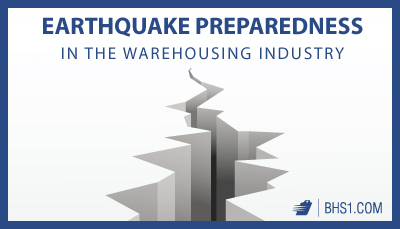We use cookies to make your experience better. To comply with the new e-Privacy directive, we need to ask for your consent to set the cookies. Learn more.
Earthquake Preparedness in the Warehousing Industry
Because of their unpredictable nature and powerful tremors, earthquakes pose a unique threat to the warehousing industry. These two qualities make it difficult to evacuate a warehouse without risking injury from toppling racks or falling merchandise.
Earthquakes will always pose a danger to people inside buildings. But there are still relatively inexpensive steps warehouse managers can take to reduce injury risks and property damage.
Prepare employees and secure items before a quake hits.
Educating staff with earthquake training is a great first step toward reducing or eliminating casualties and injuries. By knowing the safest procedures, staff will be calmer and make better choices in the event of an earthquake.
All staff should learn the rule, "Drop, cover, and hold on." It may be tempting to run outside when an earthquake starts, but this can result in severe injury or death due to falling non-structural items. Instead, employees should find the safest spot and stay put until the tremors subside.
The corollary to this rule is to secure racking and merchandise to minimize the amount of falling materials. When staff have a safe place to wait out an earthquake and racks stay in place, injuries and property damage are kept to a minimum.
Bolted feet and horizontal bars at shelf-tops help prevent racks from collapsing.
In earthquake-prone areas, warehouses need the most secure racking. While bolted feet are a good start (and required in some states), strong earthquakes can pull them from the floor. Tying shelves together at the shelf-tops with horizontal bars is the best way to ensure structural integrity of the shelving. Cross-bars should be comparable in strength to the racking posts.
Falling merchandise also poses a major threat to workers. Here are some simple tips to mitigate the risk.
-
Secure boxes on shelves. Bungee cords may be sufficient for lighters boxes, but metal bars may be necessary for heavier loads.
-
Keep heavier items on lower shelves.
-
Keep gas cylinders in secure housing.
No matter how secure your merchandise is, injury risks will increase if employees attempt to run outside during a quake. Therefore, it's crucial to have an earthquake preparedness plan that includes employee education.
Choose racks and shelving with appropriate seismic ratings.
Like buildings themselves, "non-building structures" such as racking systems can be rated according to certain seismic standards. There are several of such ratings systems, but the important thing is to choose warehouse infrastructure that has the highest-possible rating for safety and stability in the event of an earthquake.
For instance, BHS standard battery stand designs are engineered and manufactured to attain seismic certification* in a Seismic Zone 4, which describes areas with the greatest risk of earthquakes, such as coastal California. To learn more about seismic standards and how they apply to warehouse equipment, click here.
Your plan should identify safe places to take cover and managers should teach employees about those places.
Frequently, earthquakes build in intensity over several seconds. This gives staff a minimal but crucial period to take cover. Getting under the lowest and most stable shelf is often the best option in a warehouse setting.

Once in a secure location, staff should kneel or crouch with their hands over their heads. Once the quake ends, management will have to decide whether to evacuate the building or not. The state of Oregon has published a checklist that can help managers decide whether an evacuation is necessary based on post-earthquake conditions.
The Occupational Safety and Health Administration (OSHA) recommends practicing earthquake procedures at least twice per year to reinforce safe behavior. Seismologists still can't predict the precise arrival of an earthquake, but by securing your racking and merchandise and educating employees, you'll be prepared whenever one affects your warehouse.
* BHS battery stands are seismic certified on an individual basis for the physical address where the racks are to be installed. Accurate charger and battery loads for the racks, as well as soil and concrete slab data for the facility, must be provided for seismic evaluation and certification.
References:
"Earthquake Damage Checklist." Oregon. Oregon Military Department, 1 July 2009. PDF. 26 Sept. 2017.
"Earthquake Preparedness and Mitigation Guidance for Oregon State Agency Offices and Warehouses." Oregon. State of Oregon, Jan. 2004. PDF. 26 Sept. 2017.
"Earthquake Preparedness and Response." OSHA. Occupational Safety and Health Administration, U.S. Department of Labor, n.d. Web. 26 Sept. 2017
"Earthquake Preparedness Suggestions for the Nevada Warehouse Merchandising Industry." NBMG. Nevada Bureau of Mines and Geology, n.d. PDF. 26 Sept. 2017.
